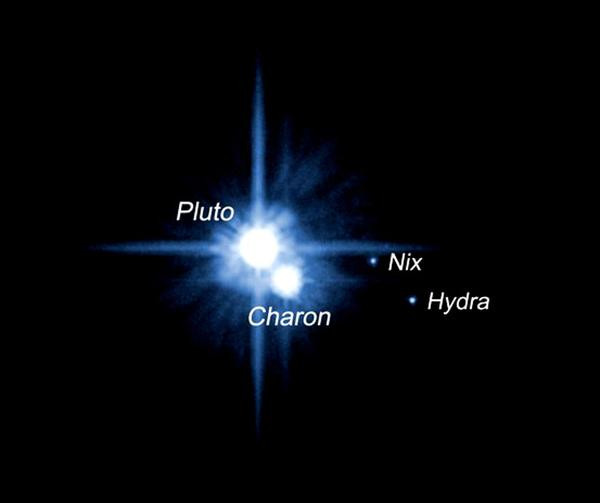
Charon, discovered in enlarged images of Pluto by James Christy in 1978, is a large satellite relative to Pluto. Charon's diameter measures 1,207.2 ± 2.8 km (≈3 times smaller than our Moon). Charon has a mass about ten times less than Pluto, and the diameter ratio is 1 to 2.
The infernal pair rotates around its common center of gravity (barycenter) like two objects connected by a rigid central bar, like a dumbbell. Charon is located only 19,000 km from the dwarf planet and moves around Pluto with a period of 6.4 days, equal to Pluto's rotation period, forming a geostationary orbit.
It seems that Charon is primarily an icy water object with very few rocks (70% rocks for Pluto). Charon could be the result of a collision with Pluto's icy mantle (unconfirmed hypothesis).
Hydra and Nix are two small satellites discovered orbiting Pluto using the Hubble Space Telescope in May and June 2005 by two American astronomers, Alan Stern and Hal Weaver. The two moons, P2 and P3, orbit at 48,708 km and 64,749 km from Pluto, much farther than Charon. They are between 46 and 167 km in diameter and are 5,000 times less luminous than Charon, orbiting in Charon's plane.
Since then, the Hubble Space Telescope has discovered a fourth moon orbiting Pluto in 32.1 days, named Kerberos since 2013. Kerberos is a very small moon with an estimated size between 13 and 34 km.
As for P5, named Styx, astronomers believe it has a potato-like shape, 10 to 25 km long. This discovery was made while preparing for the New Horizons mission flyby in 2015.
The New Horizons probe, launched on January 19, 2006, will be the first spacecraft to visit Pluto. New Horizons benefited from Jupiter's gravitational assistance, and its speed of 19 km/s is the fastest of any probe ever launched by humans.